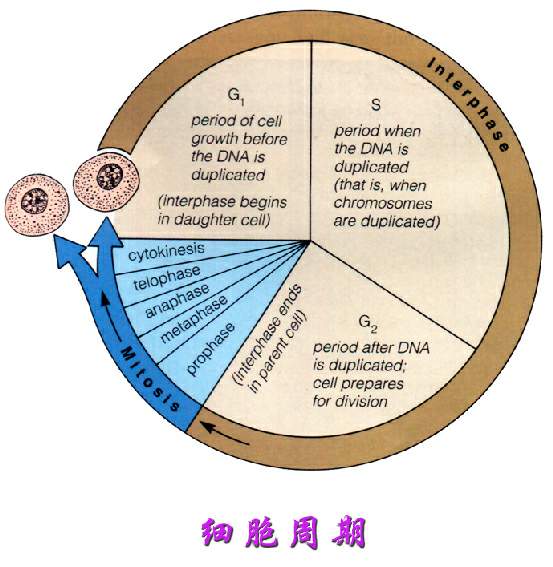In 1953, Howard and Pek had first proposed the cell cycle concept, which constitute an important part of the cell theory. Cells, from the end of the first division to the end of next division, need to go through the same stages of change (namely, G1 → S → G2 → M) again and again. This kind of growth, division of cell is known as the cell cycle. A cell cycle includes mitosis (M) and Interphase (G1, S, and G2). Although the time of each phase of cells is different, but in relative terms, M is the shortest while S phase is much longer.

Figure 1 is a cell cycle
Cell Cycle is series of events in order that ultimately leads to cell growth and division. The cell cycle of eukaryotic can be divided into interphase and cell division phase. During the interphase, the cell accumulates the nutrient and replicated DNA required by mitosis, called mitosis (M) phase. Through studying the molecular mechanism of cell division, the cell division phase can be divided into three phases, G1, S and G2. Therefore, cell cycle consists of four phases: G1, S, G2, and M.
Cells enter G1 phase after being released from mitosis, RNA and protein undergo synthesis during this period, but there is no DNA replication at this stage. The initiation of DNA replication marks the transformation of G1 to S phase. S phase extends to the time when all of the DNA replication has been completed. In the S phase, the composition of all DNA has all changed from diploid 2n to 4n. The end of S phase until mitosis is called G2 phase. During this stage, the cells have two complete sets of diploid chromosomes. The increase of the volume of the nucleus mainly happens in the S phase, when the protein can accumulate and correspond to the replication of DNA. Chromatin is maintained condensed with no visible changes in morphology.
The regulatory proteins of cell cycle are capable of binding to the coding proteins in the cell differentiation period and activate the corresponding protein kinases, thereby promoting cell division. There have been at least found of 11 different types of cyclin, respectively, being A, B1, B2, C, D1, D2, D3, E, F, G and H. Eight of the major cyclin had been separated. Depending on the difference of regulation of the phase of cell cycle through cyclin, it can be divided into G1 phase and M phase two categories. Various types of cyclins all contain a conserved sequence containing about 100 amino acids, called cyclin box, mediating the binding between cyclin and CDK. The animal cell cycles can be regulated by many kinds of cdk- cell cycle protein complexes with the activated CDK1 being able to phosphorylate the target proteins to produce the corresponding physiological effects, such as causing the phosphorylation and further disintegration of lamin, the disappearance of nuclear membrane as well as phosphorylation which leads to the condensation of chromatin.
The result of these effects is the constantly proceeding of the cell cycle. The activation time of various forms of Cdc2 and cdk illustrates a model: the regulatory function of cdk2-G1 cyclin dimer occurs at G1 and S phase while the Cdcc2- cyclin A, B regulating the mitosis (Orlando DA, 2008).
It has been found of many in vivo factors that can stimulate or inhibit cell proliferation, such as a variety of hormones, serum factor, polyamines, proteolytic enzyme, neuraminidase, cAMP, cGMP and diacylglycerol (DG), inositol triphosphate (IP3) and Ca messenger systems. The increased intracellular cAMP concentration has inhibitory effect on the cell proliferation. Those factors that can increase the intracellular cAMP level can all inhibit the proliferation of the cells, decreasing the cell growth; on the contrary, those factors that decrease the intracellular cAMP content can promote DNA synthesis and cell proliferation. The cAMP content of each period of the cell cycle is also not the same (see table).
In the cell line of the Chinese hamster ovary, the content of cAMP in M phase is the minimum, while after M phase, the level of cAMP can increase by three times. From early G1 phase to late G1 phase, the cAMP levels drop down to a moderate level and maintain at a low level until S phase. There are many experiments indicating that cGMP also play regulatory role on cell proliferation. For example, addition of cGMP or dibutyryl cGMP to the 3T3 phase of the G1 phase can induce increased DNA content and promote cell division. For example, raising the level of intracellular cGMP can promote cell mitosis. On the contrary, drugs of mitotic-promoting can also increase the concentration of cGMP. The cAMP can inhibit cell division, promote cell differentiation, cGMP is able to inhibit cell differentiation, promote cell proliferation. In cells of normal growth, cAMP and cGMP can be maintained at an appropriate level, regulating and controlling the operation of the cell cycle (Browne G, 2010).